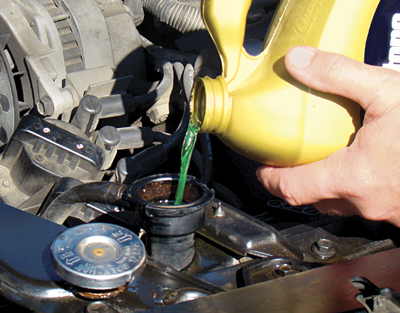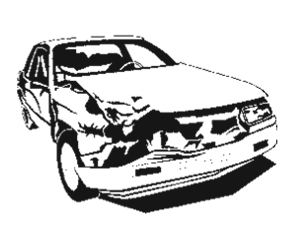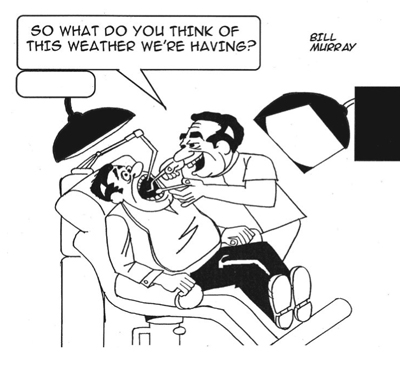VEHICLE
SAFETY

Unless
you live way up north ...
A
50-50 antifreeze mix is probably best for your car's cooling system
It's
a common mistake for do-it-yourselfers. Before the coldest weather,
or when they suddenly realize the belowzero stuff is approaching, they
drain their radiators. So far so good.
Because
they want to be extra nice to a car, they fill the radiator with straight,
uncut antifreeze. According to Tom and Ray (Click and Clack, the Tappet
Brothers), this is a mistake. On good authority, they say antifreeze
mixed half-and-half with water has a lower freezing point and a higher
boiling point. The
50-50 mix offers freeze protection up to -34 degrees and boilover protection
up to 265 degrees.
For
colder climes, a mix of 70 percent coolant and 30 percent water gives
freeze protection to -84 degrees and boilover protection to 275 degrees.
Antifreeze
has another function. It keeps the cooling system from rusting. The
rust protection breaks down over time. Change coolant every year or
as recommended by your owner's manual. It also removes dirt and rust
particles that can plug up the system and cause problems either in winter
or summer.
Green-colored
antifreeze can be used in any car. Long-life coolants in other colors
should be used on recent models. It can damage gaskets in older cars.
An
engine that boils over or freezes can cause any number of dangerous
situations, all of which are avoidable.
If
your coolant boils and expands, or if it freezes, the engine block will
be permanently damaged. That brings a very, very expensive repair job.
Check
on how a car will hold up in a crash

A
car crash is the most serious safety risk most people face.
You
can decrease your risk of serious injury by wearing a seatbelt, obeying
traffic laws, and driving sober, but what you drive also counts.
According
to a recent study by the Insurance Institute for Highway Safety, improved
seat belt and side air bag features have made many cars safer.
But,
don't assume size or luxury buys crash protection.
For
example, a number of new midsize SUVs have been reengineered for the
2008 model year. The institute found some improvement in front crash
test performance but most models were still not state-of-the art in
side crash tests.
The
Ford Taurus X won the institute's SUV Top Safety Pick for 2008.
If
you want to shop safety, a number of Web sites offer car safety ratings.
To
compare safety performance, go to www.iihs.org.
Click on "Vehicle Ratings" to see how your vehicle compares
with others on the road. You can compare one car with others in its
class.
Safercar.gov
offers the federal crash rating (five star system) but also has complete,
readable safety descriptions and even photos of the crash tests when
safety concerns are noted.
Using
gas-powered equipment
Each
year, more than 400,000 people are treated in emergency rooms for injuries
from outdoor equipment. Before starting your snowblower or other gaspowered
machines, check that safety devices are in place and function properly.
Handle gasoline with care.
Never
fill gas the tank while the engine is running. Wipe up spills, and store
fuel in an approved container away from the house. Never smoke while
using gasoline.
Speaking
of Safety
Volunteers
point the radar guns
Residents
of some communities in the U.S. are tired of speeders, so police departments
are arming them with radar guns.
The
volunteers can't issue speeding tickets, but they report offenders to
the police department. Depending on how fast the drivers were going,
usually 13 mph over the speed limit, the offenders receive a warning
letter from the police department.
Typically,
the volunteer serves in a three-hour stint and must remain in his or
her car while using the radar gun.
Speeding
reduces the amount of time available to avoid a crash. It significantly
increases the likelihood of crashing, and it increases the severity
of a crash once one occurs.
Check tires, don't overload
Nine
percent of passenger cars in the U.S. have at least one bald tire, according
to the National Highway Safety Administration, and 27 percent are being
driven with one or more substantially underinflated tires.
Having
adequately maintained tires can keep you driving safely and improve
your gas mileage. Check your tire pressure, tread, and alignment frequently.
A blowout could cause a fatal accident as one did recently on I-69 in
Indiana. It caused the driver of an overloaded van to lose control and
crash, killing five people and injuring others.

© 2015 TLC Magazine Online, Inc. |